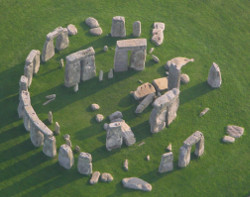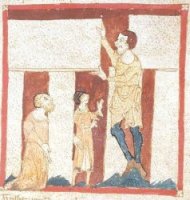
 The prehistoric megalithic site known
as Stonehenge, which is situated in the
English Amesbury in southern Wiltshire, was produced by a culture
that left no written records. Archaeology doesn't really know for what
purpose Stonehenge was build. It is suggested that it could have been
used as an astronomical observatory, a healing centre, and a
place for rituals and ceremonials.
The prehistoric megalithic site known
as Stonehenge, which is situated in the
English Amesbury in southern Wiltshire, was produced by a culture
that left no written records. Archaeology doesn't really know for what
purpose Stonehenge was build. It is suggested that it could have been
used as an astronomical observatory, a healing centre, and a
place for rituals and ceremonials.
The present Stonehenge had been thoroughly restored through the
last centuries and early pictures and drawings from the 19th century
prove that it was in a worse state before, which could raise the
question whether it was reconstructed properly enough.
|
|
|
The site exists of
a circular row of stones which originally stood upright next to
each other and were above every two stones there was placed
another stone in flat horizontal position. Within the circle there
is placed another row of stones forming an "U"-shape like a horseshoe.
In the center of the circle there is a rectangular stone which is
called the "Altar Stone".
Each stone is about 21 feet tall and weights about 44 tons. It is
not known how they where moved. It is demonstrated that it is possible
to get heavy stones in upright position by digging in the ground below.
The real problem though, which is still unanswered today, is how they
were able to place these horizontal placed stones at the top of the
standing stones. If a ramp would have been used it needed to be sturdy
enough to withstand the enormous weight pressure.
 Interestingly, the
oldest known depiction of
Stonehenge ever found is from the 14th century manuscript of the
"Roman de Brut" by the poet Wace and influenced by the
account "Historia Regum Brittanniae". It seems to depict a
large human, a giant, who seems to sets a top stone in place. (See
the image on the right.) It is likely that the idea, that giants would
have aided
in the construction of Stonehenge, could stem from the Biblical
stories that mentioned the existance of giants in the past.
Interestingly, the
oldest known depiction of
Stonehenge ever found is from the 14th century manuscript of the
"Roman de Brut" by the poet Wace and influenced by the
account "Historia Regum Brittanniae". It seems to depict a
large human, a giant, who seems to sets a top stone in place. (See
the image on the right.) It is likely that the idea, that giants would
have aided
in the construction of Stonehenge, could stem from the Biblical
stories that mentioned the existance of giants in the past.
The pseudo-historical account, the
"Historia Regum Brittanniae" (The History of the Kings of Britain), by
Geoffrey of Monmouth, a 12th century Welsh cleric, tells us that
Stonehenge was dedicated to Merlin: the wizard from the Arthurian
legend. The so-called "Bluestones" of the structure were known as
healing rocks called the “Giant's Dance”, which where brought from
Africa to Ireland by giants for their healing properties.
Merlin directed its removal from Ireland, where it had been constructed
on Mount Killaraus. Using his "gear" and skill he easily dismantled
the stones and sent them over to Britain, where Stonehenge was built.
First Ambrosius Aurelianus was buried inside the ring of stones, then
King Arthur's father: Uther Pendragon, and lastly Constantine III: the
legendary 6th century king of the Britons and nephew of king Arthur.
In fact, the Bluestones exist of the type of rock that is today known as diabase or dolerite. Specialized research done by Brittish archaeologists in the year 2008 pointed out that these dolerite Bluestones from Stonehenge contain quartz crystal, which is still being used in the field of today's alternative health care for the same purpose. (See "this article from: "The Guardian".) According to the archaeologists, the complex was percieved as a health resort, a kind of Lourdes from ancient times, because there had been found many skeletons that showed physical injuries, from which not all came from the nearby region.
This approach is in accordance with one theory that the quartz crystal within the stones was meant to harmonize the energy of its direct surroundings, including the water within the surrounding trench by which it became revitalizing and healing water. These crystals would recharge themselves constantly due to the moving ground water and perhaps the magnetic influence of the moon. (Perhaps ionization of the air plays a role in the whole process, by which the air becomes a conductor instead of a resistor.)
Quartz crystal is also used In the world of electronics to create a constant frequency or to filter out a certain frequency from other frequencies. Quartz is a piëzoelectric material, what means that it can generate an electric charge when weight pressure is applied on it. The frequencies that one can generate within the grid of the crystal are used in electronic equipment like quartz clocks and radio's. Because the surrounding standing stones are indeed under the weight pressure of the horizontal laying stones, it seems that they already knew about this effect in the ancient past and that they utilized this practically with a construction that was minimalistic but also very efficient and durable.
During this research there had also been found charcoal fragments that were dated to 7,000 BC and organic remains within the circle of the Bluestones were dated to 2,300 BC. There had been found four, possibly five, Mesolithic post-holes (one may have been a natural tree throw), which were dated to around 8,000 BC.
According to a session of
Dr. Douglas James Cottrell, Stonehenge would have been built by the
ancient Atlanteans who arrived here to set up a beacon; a light. Interestingly, the
"Michael Teachings" also mentions a "beacon" that
would not have been Stonehenge itself, but a temple in the shape of a
pyramid that stood at the place were there now is a cathedral (the
Salisbury Cathedral?). Here Stonehenge would have been a monument
that was built at a much later period in time. Although there is no
archaeologic evidence to support this claim, it is known that
churches and cathedrals were often build at the place of older
non-Christian sanctuaries that were broken down for this purpose.
(Source: http://www.michaelteachings.com)
Further according to Dr. Cottrell; Stonehenge could be considered as a calendar that could mark the changing seasons. The weather in those times was greatly different - with a more tropical and stable climate - and the changing seasons were not as destinctive as today. Because the site was coordinated with the stars, they might know their growing seasons. In later times, there also came some remnants of certain lost Hebrew tribes who settled here, in particular the Benjamites. One could find similarities with this group of people, often referred to as druids, and those people who would inhabit North-America. (Source: "Rev. Douglas James Cottrell PhD: the purpose of Stonehenge in England", by Rammsteinregeln.)
This seems to relate to a certain passage about Stonehenge from the book: "The Story of Atlantis" (1896) by W. Scott-Elliott:
"A reference to the early inhabitants of our own islands may appropriately be made here, for it was in the early Akkadian days, about 100,000 years ago, that the colony of Initiates who founded Stonehenge landed on these shores -- "these shores" being, of course, the shores of the Scandinavian part of the continent of Europe, as shown in Map No. 3. The initiated priests and their followers appear to have belonged to a very early strain of the Akkadian race--they were taller, fairer, and longer headed than the aborigines of the country, who were a very mixed race, but mostly degenerate remnants of the Rmoahals. As readers of the Transaction of the London Lodge on the "Pyramids and Stonehenge," will know, the rude simplicity of Stonehenge was intended as a protest against the extravagant ornament and over-decoration of the existing temples in Atlantis, where the debased worship of their own images was being carried on by the inhabitants."
(Source: http://www.sacred-texts.com/atl/soa/soa26.php)



